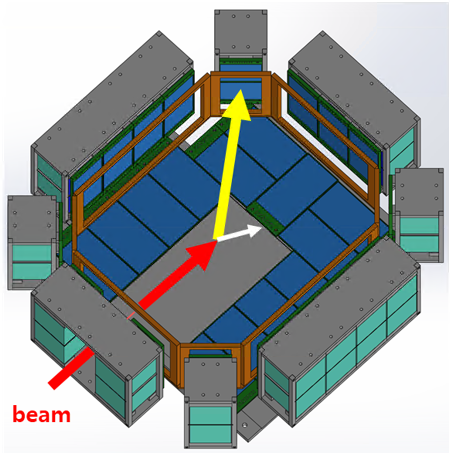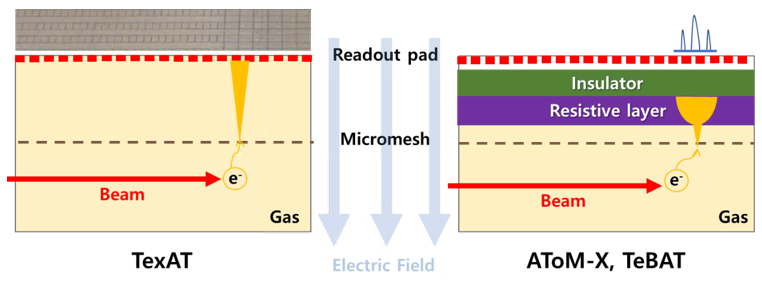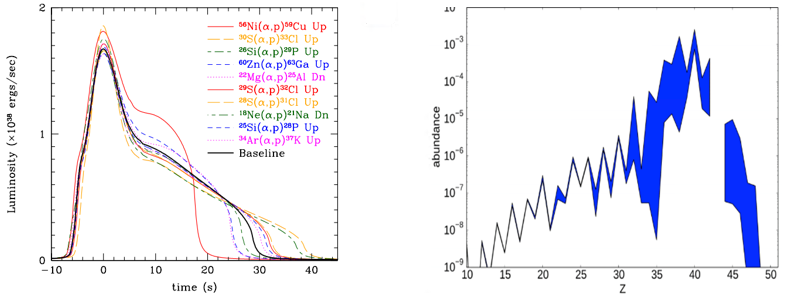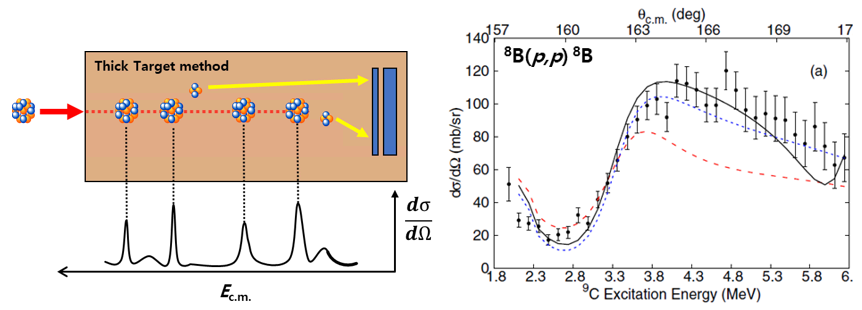Active Target Time Projection Chamber for Multiple nuclear eXperiments
(AToM-X)
1. Motivation
- 1) Direct measurement of the astrophysically-important (α,p) reactions with new detector system
- 2) Direct (α,n) cross section measurements for understanding abundance from the weak r-process
- 3) Fusion cross section measurements for nuclear structure of halo nuclei
(a) Calculated light curves of X-ray burst within a factor of 100 (R. H. Cyburt et al., 2016)
(b) Monte-Carlo variations of (α,n) rates within a factor 100 (J. Bliss et al., 2017)
2. Technique
- Measurement of charged particles from reactions (reaction vertex, track, energy and angle)
→ Excitation function (Cross Section over CoM energy) can be extracted.
- Thick Target Inverse Kinematics (TTIK): Excitation function can be obtained without changing beam energy.
(a) Schematic diagram of experimental setup and its corresponding excitation function
(b) Experimental excitation function of 8B+p elastic resonance scattering using the TTIK method (J. Hooker et al., PRC 2019)
3. AToM-X Development

- AToM-X: Active target TPC for Multiple Nuclear Experiment
- Specification
- Active area: 244(X) x 185(Y) x 289(Z) mm3
- Target gas: CH4, C4H10, CD4, He/CO2(90/10%) and CO2
- 5050 channels in total (4000 from Micromegas,1050 from aux detectors)
- Details
- Field cage : providing uniform electric field
- Electrons created along the trajectory of the charged particles can drift inside the active volume.
- Reaction vertices can be estimated from the electronic signals induced by the drift electrons.
- Auxiliary detectors : measuring the recoiling particles
- Position and energy information of the charged particle can be obtained.
- Silicon detectors: newly-designed “X6” model (position resolution improved)
- CsI Scintillator and siPM for gamma rays and high energy charged particle measurement
- Micromegas : reconstructing tracks of particles
- Micro pattern read-out pad + mesh + GEM
- Drift electron avalanched by GEM and micromesh
- Resistive technique adopted position resolution improved (expectation ~ 200um)

- Electronics and Data Acquisition system
- General Electronics for TPCs (GET) system based on the ASIC used
- handling the large number of channels with high data transfer rate
- ZAP board for bias and signal processing
(a) Photograph of a single AsAd board (E. C. Pollacco et al., NIMA 2018)
(b) A schematic drawing of the ZAP board
- Simulation and data analysis
- GEANT4 simulation for geometrical efficiency, yield estimation, particle track reconstruction.
- Garfield simulation for the electric field and the electrons’ behaviour
- Data analysis software using the machine learning method
(a) An example of the track of the drift electrons obtained by Garfield simulation
(b) (b) Drift velocity of the electron in the field cage
4. Planned Research Topics
(a) Artistic representation of a binary star system (NASA/CXC/M.Weiss)
(b) Comparison of experimental and calculated cross section for 69Ga(α,n) and 69Ga(α,2n) reactions (J. Bliss et al., 2017)
- Measurement of (α,p) reactions affect on the characteristics of X-ray burst phenomena
→ 22Mg(α,p)25Al, 18Ne(α,p)21Na, 17F(α,p)20Ne, 30S(α,p)33Cl, and so on
- Measurement of (α,n) reactions affect on the heavy element synthesis
→ 69Ga(α,n)72As, 84Se(α,n)87Kr, 94Sr(α,n) 97Zr, and 100Mo(α,n)103Ru, and so on
- High-quality beam (energy, intensity, size, and so on) also required
- Feasibility at various facility is under considering.
5. Project Timeline







